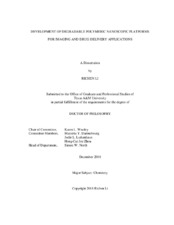| dc.description.abstract | Degradable polymers have gained increasing interest in the molecular probe and nanomedicine research, which avoid safety concerns of non-degradable materials after long-term accumulation in the human body. This dissertation focuses on the rational design and synthesis of biocompatible polymers, based on polyphosphoesters (PPEs) and poly(glucose carbonate)s (PGCs), which are capable of serving as non-immunotoxic antifouling coatings for molecular nanoprobes to accurately image tumors, or formulating well-defined functional nanocarriers for therapeutics to effectively treat osteosarcoma lung metastasis or bacterial infections.
In the first study, zwitterionic PPEs (zPPEs) were developed as coating materials for gold nanoparticles (AuNPs), which showed minimal immunotoxicity and advanced antifouling property. The PPE was synthesized by a rapid organocatalyzed ring-opening polymerization (ROP), followed by post-polymerization modification via the thiol-yne click reaction to afford the zPPEs. Degradability of the zPPEs was investigated in nanopure water (pH 5-6), which proceeded to ca. 75% after 2 d, and ca. 90% by 7 d, consistent with the degradation profiles of the zPPE-coated AuNPs. Compared to their counterparts coated with poly(ethylene glycol) (PEG), the zPPE-coated AuNPs showed similar sizes and low immunotoxicity. Moreover, significantly reduced cytokine adsorption was observed for the zPPE-coated nanoparticles. The degradability, biocompatibility and advanced antifouling property demonstrate the zPPE to be a potential PEG alternative coating material for molecular nanoprobes.
To circumvent potential drawbacks of our previous PPE system, namely the production of ethylene glycol and phosphoric acid upon hydrolytic degradation, sugar-derived PGC-based polymers were developed in the second study, which was utilized to formulate functional
nanocarriers for anticancer drugs to treat osteosarcoma (OS) lung metastases. Two PGC-based block polymers and one dimeric paclitaxel pro-drug (diPTX) were designed to be co-assembled into nanoparticles with tunable sizes and surface charges as a redox-responsive nanomedicine. The formulation showed sustained release of the PTX free drug in the presence of glutathione, a reducing agent existing at high levels in tumor tissues, thereby resulting in significant selectivity in killing cancer cells over healthy cells. Both in vitro and in vivo anticancer studies confirmed the capability of the formulation to penetrate tumor tissues and inhibit tumor cell growth, indicating its promise for the treatment of OS lung metastases.
In the third study, a novel PPE-based triblock polymer was designed and synthesized, which avoided the hydrolytic degradation product ethylene glycol, and allowed for facile construction of silver-loaded Janus nanoparticles as a potential antimicrobial. The polymer was synthesized by a one-pot sequential organocatalyzed ROP of a cyclic phosphotriester and L-lactide with PEG as the macroinitiator, followed by post-polymerization modification via the thiol-ene click reaction. Biocompatibility of the polymer was confirmed by cytotoxicity assays. The well-defined silver-loaded Janus nanoparticles were then prepared by simply irradiating the mixture of the PPE-based polymer and silver acetate solutions under UV for a few minutes. Within 2 h dialysis against nanopure water, ca. 50% of silver was released from the Janus nanoparticles, with the remaining silver released in a much slower manner over 40 h, which could be beneficial in treatment of bacterial infections. | en |


